Donn and Marcos
Things To Do
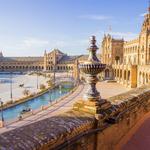
Plaza España & Parque de María Luisa
The Plaza de España ("Spain Square", in English) is a plaza in the Parque de María Luisa, in Seville, Spain. It was built in 1928 for the Ibero-American Exposition (Worlds Fair) of 1929. It is a landmark example of Regionalism Architecture, mixing elements of the Baroque Revival, Renaissance Revival and Moorish Revival (Neo-Mudéjar) styles of Spanish architecture. Many tiled alcoves were built around the plaza, each representing a different province of Spain. The Plaza de España has been used as a filming location, including scenes for Lawrence of Arabia and Star Wars: Episode II – Attack of the Clones. Surrounding the plaza is the gorgeous Parque de Maria Luisa, home to many monuments, museums, buildings, ponds and fountains. It makes for a fantastic stroll.
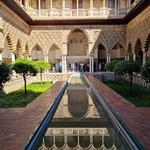
Royal Alcázar of Seville
The Royal Alcázar of Seville, historically known as al-Qasr al-Muriq, is a royal palace in Seville, Spain. It was built by Castilian Christians on the site of an Abbadid Muslim alcazar, or residential fortress. The palace is a preeminent example of Mudéjar style in the Iberian Peninsula, combining Romanesque, Gothic, and Renaissance structural elements. The upper stories of the Alcázar are still occupied by the Spanish royal family when they visit Seville. A filming location for many productions, including recently as the region of Dorne in Game of Thrones, the gorgeous palace and gardens certainly worth a visit!
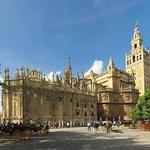
Catedral de Sevilla and Giralda Bell Tower
The Cathedral of Saint Mary of the See, better known as Seville Cathedral, is a World Heritage Site, along with the adjoining Alcázar palace complex and the General Archive of the Indies. It is one of the largest churches in the world as well as the largest Gothic church in the world. After its completion in the early 16th century, Seville Cathedral supplanted Hagia Sophia as the largest cathedral in the world, a title the Byzantine church had held for a thousand years. Along with the church itself, the Giralda is the bell tower of the Cathedral of Seville. The Giralda is the former minaret of the mosque that stood on the site under Muslim rule, and was built to resemble the minaret of the Koutoubia Mosque in Marrakech, Morocco. It was converted into a bell tower for the cathedral after the Spanish Reconquista.
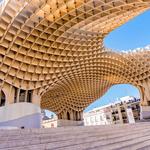
Setas de Sevilla
Setas de Sevilla ("Mushrooms of Seville") or Las Setas ("The Mushrooms") is a large, predominantly wood structure located at La Encarnación square in the old quarter of Seville, Spain. It accommodates a traditional market, restaurants, a performance square, archaeological museum — and 'rooftop' terrace with a gorgeous panoramic view of Seville's old city. This structure is actually the largest wooden structure in the world- check it out!
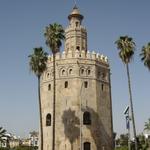
Torre del Oro
The Torre del Oro (Arabic: بُرْج الذَّهَب, 'Tower of Gold') is a dodecagonal military watchtower in Seville. It was erected by the Almohad Caliphate in order to control access to Seville via the Guadalquivir river. Constructed in the first third of the 13th century, the tower served as a prison during the Middle Ages. Its name comes from the golden shine it projected on the river.
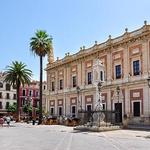
Archivo de Indias
The Archivo General de Indias ( 'General Archive of the Indies'), housed in the ancient merchants' exchange of Seville, Spain, the Casa Lonja de Mercaderes, is the repository of extremely valuable archival documents illustrating the history of the Spanish Empire in the Americas and Asia. The archives are rich with autograph material from the first of the Conquistadores to the end of the 19th century. Here are Miguel de Cervantes' request for an official post, the Bull of Demarcation Inter caetera of Pope Alexander VI that divided the world between Spain and Portugal, the journal of Christopher Columbus, maps and plans of the colonial American cities, in addition to the ordinary archives that reveal the month-to-month workings of the whole vast colonial machinery, which have been mined by many historians in the last two centuries. It provides a truly authentic space to learn about the complex - and often dark- history of European colonization, oppression, and economic development.
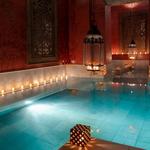
Aire Ancient Baths
Built on the foundations of an ancient first-century Roman thermal bath that was later converted into an Arab bath, its Mudéjar coffered ceilings, vaults and Roman masonry are a journey to the past, right in the heart of the Santa Cruz neighborhood. The Sevilla outpost of AIRE Ancient Baths are spread across more than 12,000 square feet and includes multiple hot and cold pools, a hammam, as well as a host of treatments.
Triana
The Triana neighbourhood is one of the underpinning elements of Sevillian culture, a breeding ground of flamenco singers, dancers and guitarists and a neighbourhood of potters that group together in the Plaza del Altozano square, next to the Triana Bridge. The origins of the neighbourhood can be traced back in history to when the Roman legions established themselves there. The Almohads built a rudimentary bridge that linked the neighbourhood with the city, and that was later turned into the Triana Bridge. Triana is probably the best neighborhood in Sevilla to catch a flamenco show. You can also tour the famous Triana market, shop local artisans, or just get lost in it's charming streets.
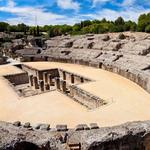
Ruins of Itálica
Italica Spain was the first Roman city in Spain, the settlement dates from the 2nd century BC through to the 4th century AD. It was a settlement of some note, home to the 3rd largest Roman amphitheater - and today it’s considered to comprise the best Roman ruins in Spain. The great Roman General Publius Cornelius Scipio chose Italica as a place to settle his war veterans who fought Hannibal and the Carthaginians in the Second Punic War. Itálica was so called as because of the Italian origins of the veterans who made it home. Italica’s reputation and status in the Roman Empire thrived as it was the birthplace of 2 Roman emperors: Trajan and Hadrian. Italica makes for an easy and fantastic day trip from Sevilla.